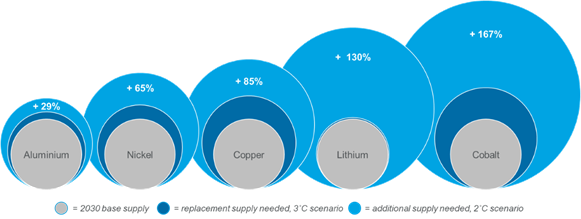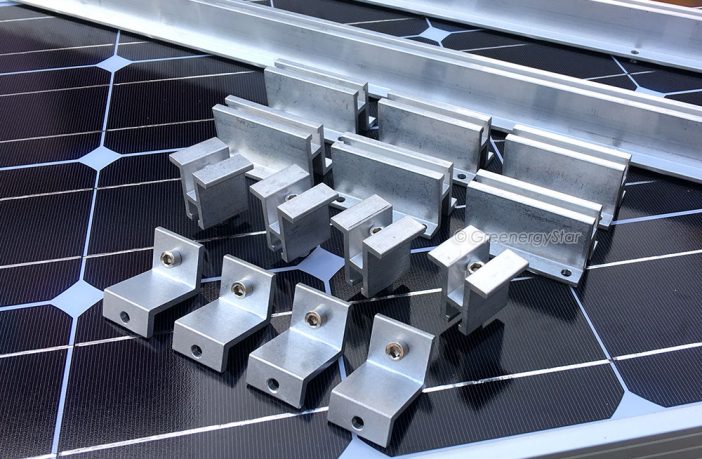- Another commodities supercycle is on the horizon, but it will be different from any that have come before.
- Fossil fuels won’t be in the vanguard and the winners will be the industrial metals needed to electrify society – cobalt, lithium, copper, nickel, and aluminium.
While post-pandemic government stimulus packages have provided a sugar rush for commodities and prices of base metals have surged, this in itself is not supercycle material. But the markets have also sensed that the energy transition is now gathering serious momentum and is likely to fuel a sustained increase in demand over the next two decades, supporting a new supercycle narrative.
US$50 trillion of investment will be needed over the next three decades to achieve a 1.5˚C global warming trajectory. This will electrify societies’ infrastructure and engineer out the aspects of economic activity that most significantly contribute to carbon emissions. Metals supply will play a vital role in achieving this.
As noted in the Wood Mackenzie, a Verisk business (Nasdaq:VRSK), report ‘Champagne supercycle: Taking the fizz out of the commodities price boom’, three potential developments could challenge how this commodities supercycle unfolds and who, ultimately, benefits from it:
- The concentrating control of metals’ supply chains is likely to exclude many from the party.
- Systemic supply uncertainty and ensuing price volatility, encouraging disruptive new technologies such as next generation electrofuels, polymeric energy storage, and cobalt free batteries – thereby forcing ‘traditional’ commodities into obsolescence.
- The rise of ‘consumption consciousness’, undermining the long-term reliance on primary metal.
Simon Morris, Wood Mackenzie Head of Metals, said: “While China’s move to secure battery raw materials is well documented, less well-known is its increasing self-sufficiency extending downstream. 75% of global lithium-ion batteries, 70% of all solar panels, and 60% of electric vehicles are made in China. But its aspirations have not yet been satisfied and we expect its control to continue to grow.
“With China dominant in its control of energy transition value chains, non-Chinese entities face an ever-diminishing share of any commodity windfall. With greater cash comes greater investment capability, enabling China to realise a strategy of supply security at any cost. Those who choose to participate too late in the cycle – be they nations seeking to secure supply for themselves, customers wanting to protect their production lines, or investors wanting to cash in on supernormal profits – are likely to find that they either can’t afford to participate or are precluded altogether.
“Price fluctuations could also throw a spanner in the works. With electric vehicles (EV) emerging as a critical source of demand, metals producers will have to consider how they supply a new type of consumer – one with an acute focus on price and supply predictability. If EV manufacturers cannot guarantee access to critical metals at an affordable and predictable price, they will look to innovate or thrift them out to the greatest extent possible. As the supply challenge materialises, the inexorable rise in prices will surely incentivise alternatives.
“As we saw with the increasing rejection of plastic usage, a greater focus on sustainability may see society react against the very considerable rise in the use of primary metals used in cars, mobile phones, telecoms, and infrastructure. Either buying less or demanding greater re-use presents a considerable downside risk for the producers of tomorrow.”
According to the Wood Mackenzie report, the forces that are shaping up to drive this boom are unique. But even for those commodities stepping into the limelight, decarbonisation creates as many risks as it does opportunities.
Under Wood Mackenzie’s proprietary Accelerated Energy Transition-2 (AET-2) scenario, which is consistent with limiting the rise in global temperatures since pre-industrial times to 2 °C, 360 million tonnes (Mt) of aluminium, 90 Mt of copper, and 30 Mt of nickel will feed the energy transition over the next 20 years. This level of additional metal presents obvious challenges for producers and consumers alike.
Morris added: “As with all commodities, the metals that are key to the transition will have to bring on replacement capacity to replace existing mines as they deplete and close. Under our base case, which is broadly consistent with a 2.8-3˚C global warming view, this requirement is manageable. However, under our AET-2 scenario, the new annual installed capacity required becomes eye-watering. By 2030, cobalt producers would need to have built 167% more supply than we currently have in our forecast, while copper would need to find 85% more mine supply than in our base-case forecasts. This will present a huge challenge for the sector.”
The additional metal supply needed by 2030 under Wood Mackenzie’s base-case and AET-2 scenarios

Source: Woodmac
While the world grapples with the magnitude of the transition and metal producers dream of what might be, other commodities are waning in prominence.
In Wood Mackenzie’s AET-2 scenario, fossil fuels’ share of energy demand falls to 50% by 2050 as low-carbon energy captures market share. Under this scenario, rapid and aggressive EV penetration leads oil demand to collapse to 35 million b/d by mid-century ‒ 70% below today’s levels ‒ and sees the oil price slump to below US$20/bbl. Thermal coal demand will also enter a steep decline. Gas demand, in contrast, remains resilient due to the deployment of blue hydrogen and opportunities from the large-scale development of carbon capture and storage (CCS) and carbon capture, utilisation and storage (CCUS) in the industrial and power sectors.
Morris said: “For the first time in the mining industry’s history, a paradigm shift in demand has been clearly signposted before it materialises. With that comes the opportunity to act before supply chains are overwhelmed. While some will see no upside, if the boom is not carefully stewarded, even those that should benefit could face structural challenges to future demand. Although this might ultimately limit the highs, it will certainly reduce the lows and, ultimately, drive a more sustainable market dynamic in the long run.”
Author: Bryan Groenendaal
Source: Woodmac















